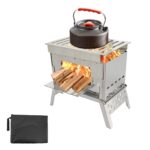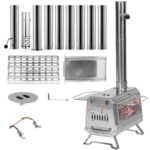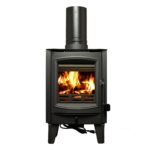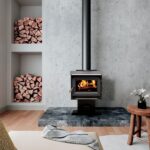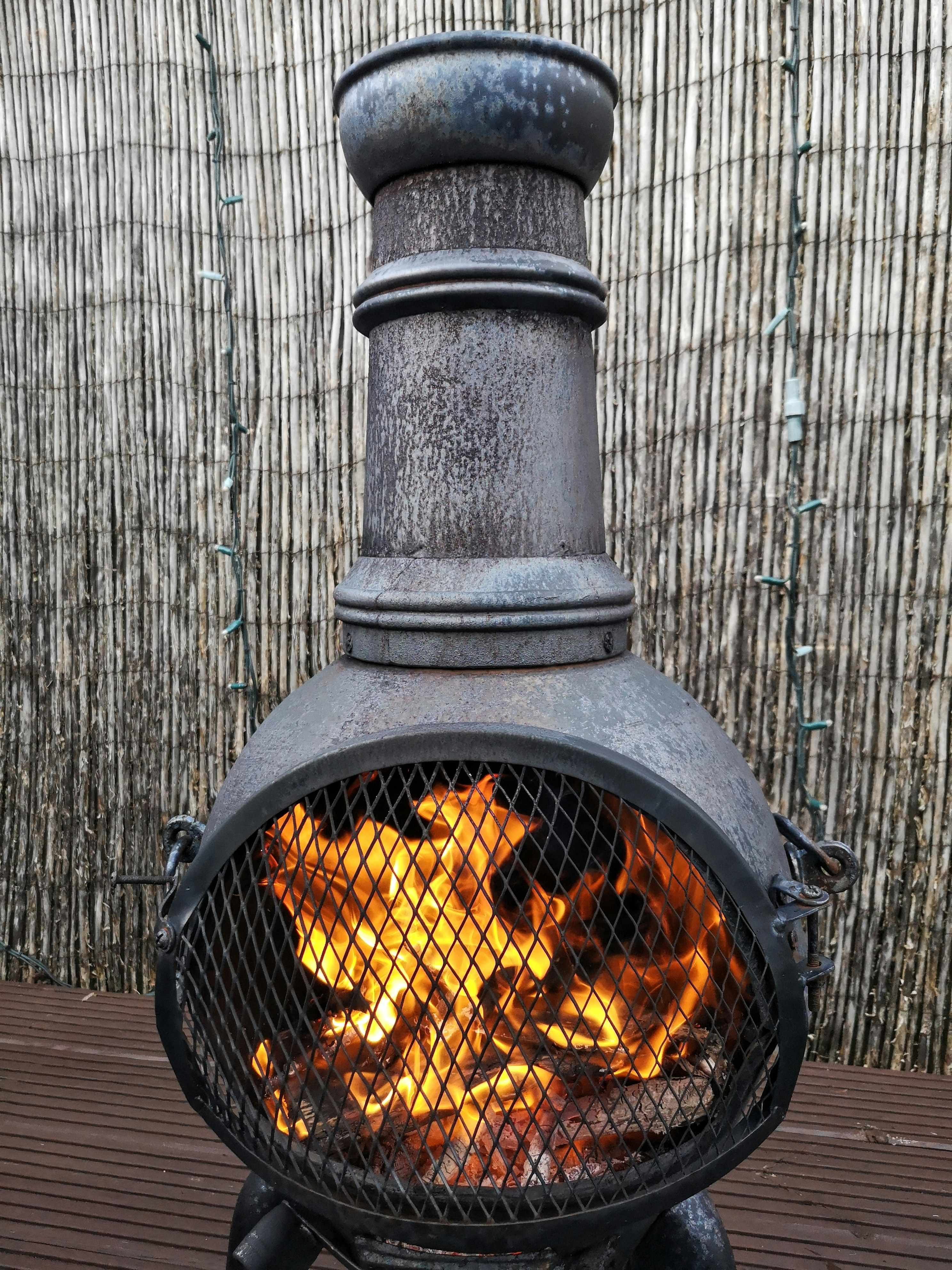
Introduction to Camping Wood Burners
Camping wood burners are portable heating devices designed specifically for outdoor enthusiasts who seek comfort and convenience during their adventures in nature. These innovative solutions have gained popularity due to their ability to provide warmth, facilitate cooking, and create a cozy atmosphere in campsites. With the ever-changing weather conditions encountered in the outdoors, having a reliable source of heat is essential for ensuring an enjoyable experience.
One of the primary benefits of camping wood burners is their efficiency in utilizing natural materials as fuel. Campers can easily gather wood from their surroundings, making these burners an eco-friendly alternative to gas or propane heaters. This option not only saves costs but also aligns with the ethos of embracing nature during outdoor excursions. Moreover, modern designs of camping wood burners often feature compact and lightweight constructions, making them easy to transport and set up at various locations.
In addition to providing heat, camping wood burners serve multiple purposes, including cooking and food preparation. Many models come equipped with cooking surfaces or grates, allowing campers to prepare meals over an open flame. This capability not only enhances the camping experience but also allows individuals to enjoy hearty and warm meals, a significant advantage during cold nights. Furthermore, the ambiance created by a wood burner can enhance the overall camping experience, inviting relaxation and fellowship around the fire.
The convenience offered by these devices is evident in their quick setup and easy usability. With advancements in technology and design, many wood burners are now portable and can be assembled or disassembled in minutes. This efficiency is particularly valuable for those who prefer to travel light but still aim for a cozy, warm environment. In essence, camping wood burners play a crucial role in enriching the outdoor experience, making them an indispensable addition for any camping enthusiast.
Benefits of Using a Wood Burner with a Chimney
Using a wood burner with a chimney during camping offers numerous advantages that enhance the overall outdoor experience. One of the most significant benefits is improved ventilation. The chimney effectively channels smoke and fumes out of the cooking area, ensuring that the air quality remains clean and safe for campers. This feature is especially important during meal preparation, where residual smoke can not only affect flavor but also pose health risks to individuals sensitive to airborne irritants.
Furthermore, a wood burner equipped with a chimney significantly reduces smoke exposure within the immediate vicinity. Traditional campfires can produce excessive smoke that can irritate the eyes and throat, making it uncomfortable to enjoy the outdoors. By directing smoke upwards and away from the gathering area, campers can breathe easier and focus on enjoying their surroundings and culinary activities.
Safety is another crucial factor that supports the use of a wood burner with a chimney. By providing a controlled outlet for combustion gases, the chimney minimizes the risk of carbon monoxide buildup, a serious hazard commonly associated with enclosed spaces. Additionally, the design of these burners often encompasses protective measures that further lower the chances of accidental fires or hazards arising from heat exposure.
In terms of efficiency, wood burners are exceptional in their ability to generate heat. They maximize the use of natural wood fuel, which is abundant in camping environments, making them an eco-friendly option. Moreover, these burners require less fuel than traditional open fires, making them a more efficient choice for heating. This efficiency not only conserves natural resources but also contributes to a sustainable camping experience.
Overall, the advantages of using a wood burner with a chimney extend beyond mere convenience. They encompass health, safety, efficiency, and sustainability, making them a wise choice for any camping enthusiast committed to enhancing their outdoor adventures.
Choosing the Right Camping Wood Burner
Selecting the appropriate camping wood burner is a critical decision that can significantly enhance your outdoor experience. When considering a wood burner for camping, several factors must be evaluated to ensure it meets your specific needs. First and foremost, assess the size and weight of the burner. A compact and lightweight design is essential for portability, as it facilitates easy transport in your camping gear. Look for models that can be efficiently packed without compromising performance.
Material plays a vital role in the durability and efficiency of a camping wood burner. Stainless steel and high-grade alloys are common materials that offer resilience against rust and endure high temperatures. Additionally, consider burners with a ceramic or heat-resistant coating, as these can help in efficient heat retention and provide added safety.
The design of the wood burner, especially the inclusion of a chimney, is another crucial factor to take into account. A chimney helps direct smoke away from the cooking area and enhances ventilation, ensuring a safer and more comfortable atmosphere. This feature is particularly beneficial in enclosed spaces, as it minimizes smoke buildup. Furthermore, examine any additional features that might enhance usability, such as adjustable airflow controls or integrated cooking surfaces.
Ease of use is often dependent on the design and features of the burner. Opt for models with straightforward assembly processes and easy operation to ensure that it can be set up quickly, allowing you to focus on enjoying your camping activities. By carefully considering these factors—size, weight, material, design, and usability—you can select a camping wood burner that effectively meets your outdoor needs, enhancing both convenience and enjoyment during your trips.
How to Set Up Your Wood Burner with Chimney
Setting up a camping wood burner with a chimney requires careful attention to detail to ensure safety and efficiency. Begin by choosing a stable and level surface that is at least 10 feet away from any flammable materials such as tents or foliage. This positioning is crucial for preventing accidental fires while allowing adequate airflow for the wood burner. Ensure that the area is clear of any debris and that the ground is firm enough to support the burner safely.
Once you have selected the appropriate location, it is essential to assemble the wood burner and its chimney components according to the manufacturer’s guidelines. Start by placing the stove body in the designated area. Attach the chimney sections, ensuring they fit snugly together. A secure connection prevents smoke and harmful gases from escaping into your camping area. It’s advisable to use a high-temperature sealant or clamps to further ensure the stability of the chimney.
After assembling the chimney, position it at an angle that allows smoke to vent away from the cooking area effectively. Make sure the top of the chimney is at least three feet above the burner to facilitate efficient smoke flow and prevent backdrafts. If your burner comes with a spark arrestor, fit it on top of the chimney to avoid potential fires caused by embers escaping.
Before lighting your burner, double-check all connections and components. Ensure the chimney is securely fastened and that there are no obstructions that could impede airflow. Once you are confident in the setup, light a small fire in the burner’s firebox, gradually adding wood as the fire stabilizes. Always supervise the burner while in use and keep a fire extinguisher or a bucket of water nearby for safety. Following these steps will help you create a safe cooking and heating environment with your camping wood burner and chimney.
Best Practices for Using a Camping Wood Burner
When utilizing a camping wood burner with a chimney, following specific best practices is essential to ensure efficiency, safety, and an enjoyable outdoor experience. One of the primary considerations is selecting the right type of wood. For optimal burning, seasoned hardwoods such as oak, hickory, and maple are recommended due to their high energy output and low smoke production. It is crucial to avoid using green or softwoods, as they tend to produce excessive smoke and can create creosote buildup in the chimney, potentially leading to fire hazards.
Starting the fire correctly is also vital. Begin with a small kindling material, such as dry twigs or newspaper, and build a tent of larger logs around it. This setup facilitates air circulation, which is essential for promoting a stable flame. Once the fire is established, gradually add larger pieces of wood while monitoring the flame’s size to maintain a steady burn. Consistency in adding wood can help avoid fluctuations in temperature and smoke emissions.
Safety is paramount when using a camping wood burner. Always ensure the burner is placed in a safe location, at least three feet away from flammable materials such as tents, dry leaves, or woodpiles. Furthermore, it is advisable to install the chimney correctly to ensure that smoke is directed away from the camping area. Proper ventilation is crucial, not only for fire efficiency but also for safety. Ensure that the burner is utilized in open areas or under a well-ventilated canopy, especially during windy conditions, to prevent smoke from accumulating around the campsite.
In addition to these practices, always keep a fire extinguisher, a bucket of water, or sand nearby to promptly extinguish any fires in case of an emergency. By adhering to these best practices, campers can enjoy the warmth and ambiance of their camping wood burner while prioritizing safety and environmental responsibility.
Maintenance Tips for Your Camping Wood Burner
Maintaining your camping wood burner is crucial for both safety and efficiency. Regular cleaning should be your first priority. After each use, allow the wood burner to cool down completely before removing any ash and soot buildup. A good practice is to use a small shovel and a metal container to collect the residue safely, avoiding the risk of fire hazards. Additionally, the interior surfaces should be scrubbed lightly with a wire brush to prevent creosote buildup, which can pose a fire risk if not addressed.
Inspecting various parts of the camping wood burner regularly for wear and tear is also essential. Look out for cracks or holes in the body, damage to the door seal, and any rusting that may have occurred due to moisture exposure. If any components appear to be compromised, replacing them before the next camping trip can help you avoid malfunction during use. Regular inspections will ensure that your wood burner continues to function as intended, providing warmth and cooking capabilities.
Proper storage after use is another important aspect of maintenance. It is advisable to store the camping wood burner in a dry, cool location to prevent moisture ingress, which can lead to rust and deterioration. Covering it with a breathable tarp can further protect it from dust and debris, ensuring it remains in optimal condition for your next adventure.
Finally, caring for the chimney is vital for proper airflow and combustion efficiency. Ensure that the chimney is free of blockages by inspecting it for any creosote buildup or debris. A clean chimney not only enhances the performance of your camping wood burner but also reduces the risk of smoke entering your tent or social area. By following these maintenance tips, you can ensure that your camping wood burner remains a reliable companion during your outdoor excursions.
Common Mistakes to Avoid
When utilizing wood burners with chimneys during camping trips, a number of common missteps can diminish both safety and efficiency. One prevalent error is the misuse of wood. Campers often opt for green or unseasoned wood, which can produce excessive smoke and creosote buildup in the chimney. It is crucial to select properly seasoned hardwoods, as they burn hotter and cleaner, ensuring a safer experience. By using appropriate wood types, campers can enhance combustion efficiency and reduce the risk of chimney fires.
Improper chimney setup is another frequent issue. Campers may neglect to ensure that the chimney is securely attached and positioned at the correct angle. A poorly installed chimney can obstruct airflow and lead to dangerous smoke backdrafts. It is vital to follow manufacturer instructions closely while establishing the chimney, as this ensures optimal performance. Additionally, check for any obstructions in the chimney before lighting the fire to guarantee a clear and safe path for smoke to escape.
Neglecting safety measures poses significant risks when operating wood burners. Failing to maintain a proper distance between the burner and flammable materials can result in accidents. Moreover, not using a spark guard can allow embers to escape, potentially igniting nearby brush or tent materials. It is important for campers to create a designated area with safe spacing around the burner and to use a spark guard when necessary to mitigate these risks.
Lastly, misunderstandings about the limitations of wood burners can lead to overburdening the unit. Campers may attempt to use a wood burner for cooking or heating a larger area than intended. Recognizing the specific capabilities and limitations of the chosen wood burner is essential to ensure its effective operation. Avoiding these common mistakes will provide a more enjoyable and secure camping experience with wood burners that have chimneys.
Real Life Experiences: Testimonials from Campers
Wood burners with chimneys have gained popularity among outdoor enthusiasts for their effectiveness and convenience while camping. Several campers have shared their experiences, providing insights into how these devices have transformed their outdoor adventures. One frequent camper, Jessica from Oregon, articulated that using a wood burner with a chimney allowed her to enjoy warm meals and maintain comfort even during chilly nights. “I never expected that a small burner could change our camping experience so dramatically,” she noted. The ability to cook and heat simultaneously meant her family could enjoy extended trips outdoors without relying heavily on bulky gear.
Another camper, Tim from Colorado, described the wood burner as a “game-changer” for his family camping trips. He mentioned the wood burner’s efficiency in distributing heat evenly across their tent. “We used to shiver through the night, but with the burner, we can comfortably share stories under the stars.” He appreciated the reduced reliance on gas supplies, which made their trips more sustainable and budget-friendly. Tim’s experience highlights the practical benefits of wood burners, such as easy fuel sourcing from the surrounding environment.
However, it is essential to note that not all experiences have been flawless. Some campers, like Sarah from New Hampshire, encountered challenges with setting up their wood burner initially. “It requires some skill to get it started properly, especially with the chimney setup,” she explained. Despite this, Sarah emphasized the rewards of persistence, remarking, “Once we figured it out, it made all the difference.” This mix of practical benefits and valuable expertise illustrates the impact wood burners with chimneys can have on camping, ultimately enhancing outdoor experiences while encouraging a deeper connection with nature.
Conclusion: Embrace the Outdoors with a Wood Burner
Camping is an experience that invites individuals to connect with nature, escape the hustle and bustle of daily life, and immerse themselves in the great outdoors. Among the essential gear for enhancing this experience, a camping wood burner with a chimney stands out as a valuable addition. It not only provides warmth but also facilitates cooking and creates an inviting atmosphere for relaxation, all while ensuring efficient smoke ventilation.
The benefits of using a wood burner when camping are numerous. First and foremost, they contribute significantly to comfort during colder nights. With a wood burner, campers can gather around its warmth, sharing stories while enjoying the serenity of nature. Additionally, the ability to cook meals over a wood fire adds a layer of authenticity to camping experiences, allowing for delicious culinary creations that enhance the overall adventure.
Investing in a camping wood burner with a chimney also promotes responsible camping practices. With proper smoke management, these burners minimize environmental impact and reduce the risk of wildfires by directing smoke away from campers and vegetation. Consequently, it helps maintain the pristine beauty of camping locations for future generations. Furthermore, understanding how to use these burners safely and efficiently fosters a culture of outdoor responsibility.
Ultimately, a camping wood burner is not merely a tool; it is an opportunity to deepen the camping experience. By nurturing comfort, facilitating cooking, and promoting environmental stewardship, a wood burner can transform an ordinary camping trip into a memorable escape into nature. As you plan your next outdoor adventure, consider the many advantages that come with a wood burner, and embrace the joys of the great outdoors responsibly.


